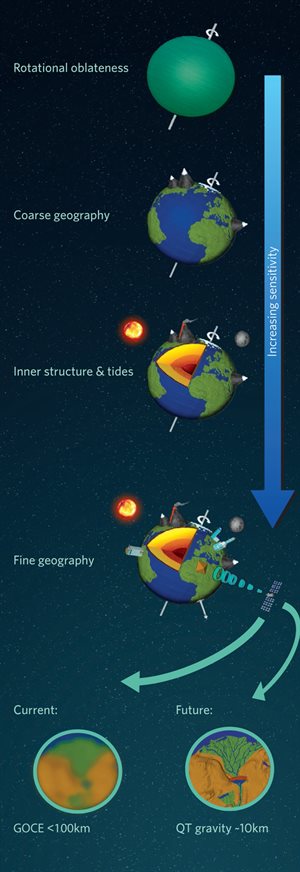 Atom interferometry in space is promising for the exploration of fundamental physics, including tests of the equivalence principle, the detection of gravitational waves and for probing quantum phenomena. Atom interferometers could also be utilised for Earth observation from space as part of a next generation gravity mission. The deployment of atom interferometers in the space environment will enable significant enhancement of their sensitivity, as microgravity allows for measurements of extended duration in free-fall. It will also permit the investigation of physical phenomena over much larger spatial and temporal scales than is possible with a ground-based instrument.
Atom interferometry in space is promising for the exploration of fundamental physics, including tests of the equivalence principle, the detection of gravitational waves and for probing quantum phenomena. Atom interferometers could also be utilised for Earth observation from space as part of a next generation gravity mission. The deployment of atom interferometers in the space environment will enable significant enhancement of their sensitivity, as microgravity allows for measurements of extended duration in free-fall. It will also permit the investigation of physical phenomena over much larger spatial and temporal scales than is possible with a ground-based instrument.
The University of Birmingham is the UK lead of the Space-Time Explorer and QUantum Equivalence Principle Space Test (STE-QUEST) consortium, which has developed a mission concept to test aspects of Einstein’s Equivalence Principle using an atom interferometer and an atomic clock. STE-QUEST aims to test the universality of free-fall by tracking the propagation of matter waves associated with two different atomic test masses in Earth’s gravity field, with a target accuracy of better than one part in 1015. The objective is to test a most fundamental prediction of Einstein’s Theory of General Relativity with high precision in the quantum regime, thereby exploring the interplay between quantum mechanics and General Relativity, and searching for hints of quantum effects in gravity.
We are also part of the Space Atomic Gravity Explorer (SAGE) consortium, which has a primary objective of detecting gravitational waves in new frequency ranges. There is a strong interest in extending the range of gravitational wave detectors towards low frequencies.
In a project funded by the European Space Agency, we are currently collaborating with UK and European partners to develop a model instrument for the generation of Bose-Einstein condensates (BECs) that would go towards a spaceborne gravity gradiometer, aiming at next generation gravity missions. We are also involved in CASPA - the Cold Atoms Space Payload project - through which we are contributing to the development of a cold atoms-based space payload for demonstration on board a cubesat.
Figure: Ψ in the sky, K Bongs, M Holynski & Y Singh, Nature Physics 11, 615 (2015), doi:10.1038/nphys3427